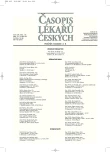-
Medical journals
- Career
Atrial Transport Function after Surgical Ablation of Atrial Fibrillation Using Cryoenergy
Authors: M. Kolek; R. Brát; J. Samlík
Authors‘ workplace: Kardiochirurgické centrum FN, Ostrava
Published in: Čas. Lék. čes. 2007; 146: 687-698
Category: Original Article
Overview
Background.
Surgical ablation is one of the most effective techniques for treatment of atrial fibrillation. Stable sinus rhythm is achieved and effective atrial contractions are restored in the majority of patients. The aim of the prospective study is to assess the presence of atrial transport function after surgical ablation of atrial fibrillation using cryoenergy and to evaluate predictors of the procedural success.Methods and Results.
Between January 2005 and September 2006, 100 consecutive patients underwent left atrium cryoablation as a concomitant cardiac procedure. Their mean age was 67.6 years (range 50 to 82 years), there were 41 (41 %) women. Forty six patients (46 %) suffered from paroxysmal or persistent atrial fibrillation and 54 (54 %) of them from permanent atrial fibrillation before surgery. Atrial mechanical function was assessed by echocardiography (pulsed Doppler examination of the mitral and tricuspidal inflow, presence of the atrial filling [A] wave) after 3.5, 6, 12 and 18 months postoperatively. 79.6 % of patients, who have had sinus rhythm at 3.5 months, were free from atrial fibrillation at 18 months after surgery. The effective left atrial contractions were present at 3.5, 6, 12 and 18 months postoperatively in 70.2 %, 71.9 %, 81.4 % and 73.5 % of patients and we found right atrial transport function in 97 %, 95.3 %, 97.7 % and 97.1 % of patients. There was no significant difference between group with paroxysmal or persistent atrial fibrillation and permanent fibrillation. Negative predictors for restoration of the left atrial transport function were: preoperative mitral stenosis (at 3.5 and 6 months, p=0.02 and p=0.03 respectively), bigger left atrial dimension prior to procedure (only at 3.5 months, p=0.01) and severity of tricuspid regurgitation before surgery (only at 18 months, p=0.01). An ischaemic stroke occured in 7 %. Thirty-day motality was 12 % (12 patients).Conclusions.
Left atrial mechanical funtion was detected in 70-80 % of patients and right atrial function in 95-98 % of patients with sinus rhythm during follow-up of 18 months. Preoperative left atrial dimension, presence of mitral stenosis and severity of tricuspid regurgitation were the most significant predictors for postoperative restoration of the left atrial transport function. Significant reduction in occurence of ischaemic stroke by surgical ablation was not achieved.Key words:
atrial fibrillation, maze procedure, cryoablation, arrhythmia surgery, atrial transport function.
Labels
Addictology Allergology and clinical immunology Angiology Audiology Clinical biochemistry Dermatology & STDs Paediatric gastroenterology Paediatric surgery Paediatric cardiology Paediatric neurology Paediatric ENT Paediatric psychiatry Paediatric rheumatology Diabetology Pharmacy Vascular surgery Pain management Dental Hygienist
Article was published inJournal of Czech Physicians

-
All articles in this issue
- Genotyping of CYP2D6 and CYP2C19
- Analysis of Circadian Rhythm Influence to Heart Rate Turbulence in Patients Post Myocardial Infarction with Left Ventricular Dysfunction
- Functional and Developmental View on Purkinje Fibers System
- Problems of the Cervical Defects
- Tuberculosis in the Czech Republic During 2006
- Atrial Transport Function after Surgical Ablation of Atrial Fibrillation Using Cryoenergy
- Factors Associated with Development of Boy’s Aggressiveness
- Journal of Czech Physicians
- Journal archive
- Current issue
- Online only
- About the journal
Most read in this issue- Genotyping of CYP2D6 and CYP2C19
- Problems of the Cervical Defects
- Analysis of Circadian Rhythm Influence to Heart Rate Turbulence in Patients Post Myocardial Infarction with Left Ventricular Dysfunction
- Functional and Developmental View on Purkinje Fibers System
Login#ADS_BOTTOM_SCRIPTS#Forgotten passwordEnter the email address that you registered with. We will send you instructions on how to set a new password.
- Career

